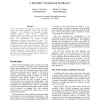Free Online Productivity Tools
i2Speak
i2Symbol
i2OCR
iTex2Img
iWeb2Print
iWeb2Shot
i2Type
iPdf2Split
iPdf2Merge
i2Bopomofo
i2Arabic
i2Style
i2Image
i2PDF
iLatex2Rtf
Sci2ools
VISUALIZATION
1991
IEEE
1991
IEEE
A Scientific Visualization Synthesizer
or vectors at every mesh point may lead to a very cluttered image. Continuous coloring or data mapping, on the other hand, provide a smooth representation of the data. The use of textures can be extended to include vector fields and contours as well. We describe methods for displaying scientific data using textures and raster operations rather than geometric techniques. The flexibility and simplicity of raster operations allow a greater choice of visualization techniques with only a small set of basic operations. In addition, texture mapping techniques will be shown that allow the representation of several variables simultaneously, without a high degree of clutter. The combination of traditional geometric techniques, image composition techniques and image rendering techniques can be integrated into a single framework for the display of scientific data. This paper presents a system for generating and operating on textures and images for the purposes of scientific visualization. The adva...
| Added | 27 Aug 2010 |
| Updated | 27 Aug 2010 |
| Type | Conference |
| Year | 1991 |
| Where | VISUALIZATION |
| Authors | Roger Crawfis, M. J. Allison |
Comments (0)

